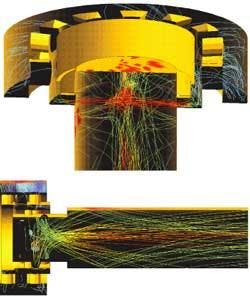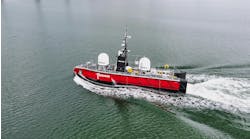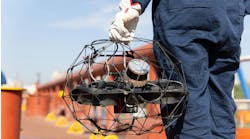COMPLETION TECHNOLOGY: New strategy for sand managementsafely improves production performance
Revenue increase of $370,000 a day or $130 million a year
Remi Eriksen
Oddmund Kvernvold
Lars Even Torbergsen
DNV Consulting
Due to the potentially severe consequences associated with sand production, such as erosion, many operators decide on a conservative approach – typically a "zero sand production" criteria or a "maximum sand free rate" criteria. These criteria generally put restrictions on the production rate (and revenue) to reduce the risk of leakage. In many cases, this is unnecessary.
Det Norske Veritas has developed a new sand management strategy, which improves the production and safety performance for fields that are capacity-restrained due to sand problems. The development of the new strategy started with a project for Conoco during the period 1996-2000. The strategy was further refined on a pilot project for Statoil in 2001 and is now being implemented in full scale on Statoil's Gullfaks B platform in the North Sea.
Erosion calculations are performed with a general particle method based on the situation, where µ is the impact velocity and a is the impact angle.
null
The pilot project was awarded the Statoil prize for the most successful R&D project in 2001. The main objective of the pilot study was to increase safety by better understanding the physical phenomenon, and at the same time assess the potential for increased production and reduced inspection and maintenance.
Traditional approach
The industry has developed technical standards and guidelines to identify minimum requirements for the design and installation of piping systems on offshore production platforms. For instance, API RP 14E, "Recommended practice for design and installation of offshore production platform piping system," recommends that flowlines, production manifolds, process headers, and other lines transporting gas and liquid in two-phase flow should be sized primarily on the basis of velocity. The rationale behind this recommendation is that experience has shown that loss of wall thickness occurs by a process of erosion-corrosion. This process is accelerated by high fluid velocities, presence of sand, corrosive contaminants such as CO2 and H2S, and fittings, that disturb the flow path such as chokes and elbows. API RP 14E provides a procedure for establishing an "erosional velocity" that is the velocity above which erosion may occur.
This procedure has some key limitations:
- Allows for a wide range of estimates
- Does not address the specific damage mechanisms such as sand production
- Does not give sufficient practical advice as to managing erosion issues during operation.
Faced with these limitations on practical guidance, operations typically adopt a "zero sand production" criteria or a "maximum sand free rate" criteria, which inherently only takes into account the amount of sand produced.
New approach
From an erosion perspective, the amount of sand produced per time unit is only one of many factors that must be managed. More important factors are sand particle velocity, impact angle, and material grading. By taking into account the production and operational characteristics of each well, the geometry and material grading of piping, pipe bends, chokes, and manifolds can lead to a more sophisticated method to manage the erosion risks associated with sand production.
The new method is a result of comprehensive full-scale erosion testing in combination with advanced computer-based simulation models to allow for evaluation of components with complex geometry such as chokes.
The first step in implementing this sand strategy is to perform a coarse screening of the wells to identify wells that, based on the production conditions, have a high potential for erosion. Typically a high gas-oil-ratio (GOR) well at low operational pressure has a significantly higher erosion potential compared to a low GOR well. This involves a pure thermo-hydraulic assessment based on the recorded pressure, temperature, and flow readings stored in the production database.
The initial step does not take into account the actual sand production. Wells that are identified as most critical may therefore not coincide with the wells having the highest erosion rate. Since the sand production in many cases is sensitive to changes in reservoir and production conditions, the wells may rapidly become critical in case the sand contents increase. The initial screening gives early and simple feedback on which wells need special attention.
The prediction method for sand erosion applies the results from flow solution and a particle track calculation to determine the erosion rate on the internal surfaces of the material.
null
The second step involves detailed assessments of the sand particle erosion rate at actual production conditions for the individual wells. Erosion calculations are performed with a general particle method based on the situation and can be presented graphically where µ is the impact velocity and a is the impact angle.
The level of details in the erosion modeling depends mainly on the geometrical complexity of the identified components. For complex geometries, more advanced tools are required to establish the erosion rate. For this DNV applies the computational fluid dynamics (CFD) program CFX4. However, other codes have the same capability.
The prediction method for sand erosion applies the results from flow solution and a particle track calculation to determine the erosion rate on the internal surfaces of the material. Specific models have been developed to calculate erosion rates based on the results from CFD simulations. These models are based on extensive testing in order to determine the erosion characteristics of the various relevant materials.
The results from the new method are the basis for developing individual operational criteria and inspection plans for the various wells.
Results
The method was tested on a pilot project for Statoil in 2001. The pilot project used three production wells on Gullfaks A, for which the production capacity was restricted due to sand production. The sand production limit was safely increased by a factor of ten for the three pilot wells giving each of these wells an average of 1,500 extra barrels of oil per day.
About 50 wells in the Gullfaks field are restricted due to potential sand production. A total retention of 30,000 b/d has been the result of the traditional sand production strategy. By using the new sand management strategy, this can be reduced by about 50%, adding a significant amount to the revenue stream. This is equivalent to about $370,000 a day or $130 million a year with an oil price of $25/bbl. Other fields in the North Sea are now looking into ways to implement this new approach.





